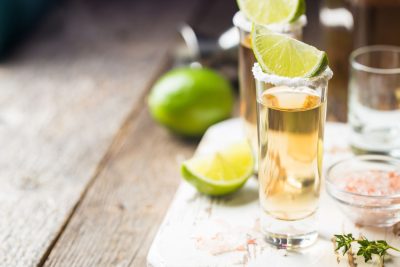Are you curious about the taste of tequila? This fiery liquor has a reputation for being a party drink, but there’s more to its flavor than just a punch to the palate. From sweet and fruity to earthy and complex, tequila can be a diverse and fascinating drink to explore. So, what does tequila taste like? Let’s dive in and find out.
Tequila has a distinct flavor that is often described as spicy, herbal, and slightly sweet. It is made from the blue agave plant, which gives it a unique taste that sets it apart from other types of alcohol.
Some people find the flavor of tequila to be quite strong and assertive, while others enjoy its complex and nuanced taste. In general, tequila is a versatile spirit that can be enjoyed on its own or as part of a mixed drink.
What does tequila taste like?
Tequila can have a wide range of flavors and taste notes depending on the type, quality, and production process. Generally speaking, the taste of tequila can be described as:
- Fresh and vegetal: The base ingredient, Agave, has herbaceous and vegetal notes; this can come across as earthy, grassy, or herbal.
- Citrusy: Some tequilas can have a citrusy or lemony taste that adds a bright, fresh flavor to the mix.
- Woody: Depending on the aging process, tequila can develop a woody oak taste that adds depth and complexity.
- Smoky: Some tequilas can have a smoky taste that comes from roasting the agave plant, which can add a distinct smokiness to the final product.
- Fruity: Some tequilas can have fruity notes like banana, tropical fruits, and even berries which makes it interesting in taste
- Sweet: some tequilas can taste sweeter than others; this can be due to the sugar content from the Agave used.
- Spicy: Some tequila may have a spicy or warm sensation that is associated with the alcohol content, in part to the high ABV.
In general, tequila can be described as a complex and dynamic drink that offers a range of flavors, aromas, and taste notes that make it unique. The aging process and type of tequila play an important role in the way it tastes.
A Blanco tequila is clear, unaged, and has the freshest taste of the agave. A Reposado is aged for a minimum of 2 months to a year and has a smooth and softer taste, and an Añejo, which is aged for at least a year up to 3 years, can have a richer and more complex taste.
Basic flavor profile of tequila
The basic flavor profile of tequila is often described as spicy, herbal, and slightly sweet. The specific flavors that are present in tequila can vary depending on the type of agave plant used to make it, as well as the production methods employed.
Some common flavors that are often associated with tequila include pepper, citrus, vanilla, caramel, and oak. Tequila can also have a slightly earthy or grassy flavor, which is often attributed to the agave plant.
Overall, the flavor of tequila is quite complex and can be quite varied, with different brands and styles of tequila offering their own unique flavor profiles.
How tequila’s flavor compares to other types of alcohol?
Tequila is a type of alcohol that has a distinct flavor profile that sets it apart from other types of alcohol. It is made from the blue agave plant, which gives it a unique taste that is often described as being spicy, herbal, and slightly sweet.
In comparison to other types of alcohol, tequila can have a stronger and more assertive flavor. Some people may find the flavor of tequila to be more complex and nuanced than other types of alcohol, while others may find it to be too strong or overpowering.
Other types of alcohol, such as vodka and gin, are often made from grains or potatoes and tend to have a more neutral flavor profile. Whiskey and bourbon, on the other hand, are made from grains and are aged in oak barrels, which gives them a rich, woody flavor.
Rum is made from sugarcane and has a sweet, tropical flavor, while beer is made from grains and has a wide range of flavors, depending on the type of grain and brewing process used. Overall, the flavor of tequila is quite distinct and can be quite different from other types of alcohol.
The role of the agave plant in shaping tequila’s flavor
The agave plant plays a crucial role in determining the flavor of the tequila, as it is the key ingredient used to make the spirit. Tequila is made by fermenting and distilling the sap, known as “aguamiel” (honey water), or the cooked and mashed heart of the agave plant called “piña” (pineapple).
Different varieties of agave are used to make different types of tequila, and each variety has its own unique flavor profile. The most commonly used agave for tequila production is blue agave, which is known for its high sugar content and robust, earthy flavor. The blue agave is primarily grown in the Jalisco region of Mexico, which is where the majority of tequila is produced.
The way in which the agave is grown and harvested also plays a role in shaping the flavor of tequila. For example, agave that is grown at a high altitude will typically have a sweeter and more floral flavor, while agave grown at lower elevations will have a more earthy and vegetal flavor.
Also, the time of year in which the agave is harvested can also affect the flavor of the tequila, with agave harvested later in the year having a more mature and complex flavor.
The way in which the agave is cooked also plays a role in shaping the flavor of tequila. Tequila that is made using a traditional method known as “pit cooking” will have a smoky, earthy flavor, while tequila that is made using modern methods, such as industrial ovens, will have a cleaner and more neutral flavor.
How the production process affects the flavor of tequila
The production process for tequila can significantly affect the final flavor of the spirit. Some key steps in the production process that can influence the flavor of tequila include:
- Harvesting and selection of the agave: As mentioned before, the variety of agave used and the way it is harvested can affect the flavor of tequila. A careful selection of agave plants can ensure that only the most flavorful plants are used in the production process.
- Cooking of the agave: The cooking process is an essential step in the production of tequila, as it converts the starches in the agave into sugars that can be fermented.
The way in which the agave is cooked, such as in a pit oven, autoclave, or industrial oven, can affect the flavor of the tequila. For example, pit ovens impart a smoky flavor, while autoclaves or industrial ovens can give a cleaner and more neutral flavor. - Fermentation: The agave sap or cooked and mashed heart is fermented to produce a low-alcohol “mosto” using natural yeasts. The type of yeast used, temperature, and duration of fermentation can affect the flavor of the tequila. For example, wild yeasts can add complexity and character to tequila, while commercial yeasts can make it more neutral.
- Distillation: The fermented liquid is distilled twice, using copper pot stills, to produce tequila. The type of still used, such as small-batch pot stills, can give a more nuanced, complex tequila, while larger column stills can produce a cleaner, more neutral spirit.
- Aging: Many tequilas are aged in oak barrels, which can impart flavors such as vanilla, caramel, and woodsy notes. The type of barrel used, such as new or used, American or French oak, and the length of aging can affect the flavor of the tequila.
- Blending: The final stage, before bottling, is to blend the tequila, which can smooth out the flavors and make it more consistent.
All these steps combined can give tequila its unique character. As with any production process, every producer has their own specific techniques, methods, and styles, which can greatly vary the final flavor profile of the tequila.
The influence of aging on tequila’s flavor
Aging can have a significant influence on the flavor of the tequila, much like it does with other aged spirits like whiskey or brandy. The aging process for tequila typically involves storing the spirit in oak barrels for a period of time.
During aging, the tequila interacts with the wood of the barrels, which can impart flavors such as vanilla, caramel, and woodsy notes. The type of oak used, such as American or French, can also affect the flavor of the tequila, with American oak imparting stronger vanilla and caramel notes and French oak imparting more subtle and delicate flavors.
Aging in new oak barrels will typically impart more woody and vanilla flavors, whereas aging in previously used barrels will typically impart more subtle and nuanced flavors. The barrels that are used for aging, previously held whiskey, brandy, port, or sherry, can also transfer those characteristics to the tequila.
The length of aging is another factor that can affect the flavor of tequila. The minimum aging time for tequila to be considered “aged” is two months, but it can be aged for much longer than that. Aged tequila often has more depth and complexity compared to non-aged tequila.
For example, Tequila Blanco is unaged, which makes it clear and crisp, relatively young and fresh, while Reposado is aged between 2-12 months, with a more complex flavor, with a lighter color and golden tones. Añejo is aged between 1-3 years and has the most complex and smooth flavor, with a dark brown color; it can be compared to whiskey or brandy.
Overall, aging can greatly influence the flavor of tequila, adding complexity, depth, and nuances that set it apart from the unaged Blanco.
However, it is important to note that aging is not necessary for good tequila, and unaged tequilas can be just as delicious, particularly if they are made from high-quality agave and produced using traditional methods.
The flavors of different types of tequila (e.g., Blanco, reposado, añejo)
The flavor of tequila can vary depending on the type of tequila, as each type is produced using different methods and aged for different lengths of time. The main types of tequila are:
- Blanco (also known as “silver” or “platinum”): Blanco is unaged tequila, which is bottled immediately after distillation. This type of tequila is clear and has a crisp, relatively young, and fresh flavor, with the taste of agave being prominent. Blanco tequilas can have a more vegetal, peppery, or citrusy taste depending on the Agave used and the production process.
- Reposado: Reposado is aged tequila, typically aged for 2 to 12 months. The aging process imparts a more complex flavor to the tequila and gives it a lighter color and golden tones.The flavors can be described as having a balance between agave and oak, with notes of vanilla, caramel, and woodsy notes. This type of tequila can have a smooth and slightly sweet taste, with a subtle smokiness depending on the aging process.
- Añejo: Añejo is aged tequila, typically aged for at least one year but less than 3 years. The aging process gives añejo tequila a dark brown color and a more complex and smooth flavor.The flavors can be described as having a balance between agave and oak, with notes of vanilla, caramel, chocolate, and spice; it can have a richer flavor with a smooth and mellow finish. It can be compared to whiskey or brandy in terms of complexity and nuances.
- Extra Añejo: Extra añejo is aged tequila, typically aged for more than 3 years. The aging process gives this tequila a dark brown color and a very complex, smooth, and nuanced flavor; this type of tequila is considered a sipping tequila, similar to the finest whiskies, cognacs, and brandies.
It’s important to note that the tequila’s profile can vary greatly between producers, even when they fall into the same category, depending on the Agave type, the region, and the production methods. Therefore, it’s a good idea to try different tequilas to find the one that best suits your taste.
How to identify and describe the flavors in a particular tequila
There are several ways to identify and describe the flavors in a particular tequila. Here are a few key steps you can take to do so:
- Look at the color: The color of tequila can provide some clues about its flavor profile. For example, a young, unaged tequila (Blanco) will typically be clear, while an aged tequila (reposado, añejo) will have a golden or brown color. The color can give an idea of the type of tequila, its age, and if it has been aged in oak barrels or not.
- Smell the tequila: The aroma of tequila can give an indication of the flavors that will be present in the taste. Before taking a sip, you can swirl the tequila in a glass and take a deep sniff to get a sense of the aroma.
Pay attention to the scents that you pick up and try to identify specific notes, such as agave, vanilla, caramel, wood, and fruit. - Taste the tequila: When you take a sip, pay attention to the flavors that you taste and try to identify specific notes.
Tequila should be sipped, not shot. Take a sip and let it sit in the mouth for a few seconds, so the taste buds can pick up the nuances, then swallow. Try to identify the flavors and note the sweetness, acidity, bitterness, saltiness, and spiciness of the tequila. - Take notes: To fully evaluate a tequila, take notes of what you smell, taste, and observe in color. This will help you remember the flavors and aromas you encountered, so you can compare different tequilas or refer back to them later.
Here are a few words that can be used to describe the flavors of tequila:
- Agave: The main flavor and scent that comes from the sap or the heart of the plant.
- Fruity: Fruity notes can range from fresh citrus to cooked or overripe fruits.
- Floral: Aromas of flowers, herbs, and other plant essences.
- Earthy: Notes of soil, wood, and moss.
- Peppery: Spicy, hot, or pungent flavors.
- Smoky: Aromas and flavors from wood-fired ovens or from barrel aging.
- Vanilla, Caramel: Flavors from the oak barrel aging.
- Chocolate, Coffee, Nutty: Notes from the barrel aging and the añejo tequilas
It’s important to note that everyone’s palate is different, and what one person may taste or smell as one thing, another person may taste or smell as something else. Also, tequilas can vary greatly between producers, even when they fall into the same category, depending on the Agave type, the region, and the production methods.
The impact of personal taste preferences on the perceived flavor of tequila
Personal taste preferences can have a significant impact on the perceived flavor of tequila. Everyone’s palate is unique, and what one person may taste or smell is one thing; another person may taste or smell something else.
For example, some people may prefer the earthy, vegetal flavors of agave that are prominent in unaged or Blanco tequila, while others may prefer the smoother, more nuanced flavors of aged tequila, such as reposado and añejo.
Some people may also prefer tequila with more sweetness, while others may prefer it to be dry and more complex. Some people may also prefer more smoky, woody, and oaky notes, while others may prefer more floral, fruity, and spicy notes.
It’s important to note that personal taste preferences can also be influenced by the context in which the tequila is being consumed. For example, the flavors that a person perceives in tequila may be different when it is consumed neat, on the rocks, or as part of a cocktail.
Some people may also prefer tequila paired with certain foods, and the flavors can change with the pairing, highlighting different notes in the tequila.
It’s also important to keep in mind that personal taste preferences can change over time. As you try more tequilas, you may develop a taste for new types of flavors and aromas.
The best way to find what you like is to try different tequilas, take notes and experiment with different ways of drinking or pairing it with food. It’s all about exploring and finding what you personally enjoy, and there is no right or wrong answer when it comes to taste preferences; it’s all about personal preference.
What does tequila taste like when it is straight?
When tequila is consumed straight or “neat,” the flavors and aromas are at their most intense and unadulterated. The taste can vary depending on the type of tequila and how it was produced.
A young, unaged tequila (Blanco) will have a crisp, fresh flavor, with the taste of agave being prominent. The flavors can be vegetal, with notes of pepper, herbs, and citrus.
Depending on the agave variety, the tequila could have floral and fruity characteristics. These types of tequilas are considered more suited for mixing with other ingredients to make cocktails, as they have a strong and clear agave flavor.
Aged tequila (Reposado, Añejo) will have a more complex and smooth flavor with a balance between agave and oak. The aging process imparts flavors such as vanilla, caramel, woodsy notes, and chocolate notes. These types of tequilas can be enjoyed straight and are considered as sipping tequilas, similar to whiskies or brandies.
Extra Añejo tequila is aged for a minimum of 3 years, and it is considered a sipping tequila; it will have a very complex, smooth, and nuanced flavor, with a balance between agave and oak, with notes of vanilla, caramel, chocolate, and spice, it can have a richer flavor, with a smooth and mellow finish.
When drinking tequila straight, it is important to let it sit in the mouth for a few seconds, so the taste buds can pick up the nuances and allow the flavors to develop.
So, sipping it slowly also allows for the alcohol to be tolerated better and the tequila’s flavor profile to be appreciated more. It is also a good idea to drink it in small amounts and take note of the different flavors and the aroma to understand the tequila’s complexity.
Conclusion
If you want clarity on what does tequila taste like, then you are just in the right place. Tequila is a versatile and complex spirit that can have a wide range of flavors and aromas, depending on the type of tequila and how it was produced. The main ingredient of tequila is the Agave plant, which gives tequila its unique and distinct taste and aroma.




